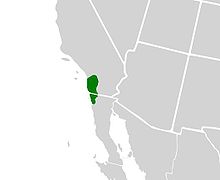Lycaena Hermes
| Lycaena Hermes | ||||||||||||
|---|---|---|---|---|---|---|---|---|---|---|---|---|

Lycaena hermes , female |
||||||||||||
| Systematics | ||||||||||||
|
||||||||||||
| Scientific name | ||||||||||||
| Lycaena Hermes | ||||||||||||
| ( Edwards , 1870) |
Lycaena hermes is a butterfly ( butterfly ) from the family of Gossamer (Lycaenidae).
description
butterfly
The wingspan of the moth is 25 to 32 millimeters. They show a clear sexual dimorphism . The upper sides of the forewings in the males are dark brown, in the lower disk area orange-yellow and have some large black-brown spots. The upper side of the forewing of the females, on the other hand, is predominantly orange and dark brown in color only in the middle, in the root area and at the edges. The hind wings of both sexes are provided with a tail near the tornus . This area is small in the males and in the females extensively colored orange-yellow on a brown background. The undersides of the forewings are light yellow in color, from which large black spots stand out. The undersides of the hind wings are almost monochrome, light yellow to yellow-orange. This characteristic together with the tails makes the moths distinctive.
egg
The white eggs are deposited individually on the food plant.
Caterpillar
Adult caterpillars have a strong green base color, a dark green back line, yellowish side stripes, pale slashes and a shield-like elevation behind the head.
Doll
The pupae are grass green and show small brown dots and yellow slashes.
distribution and habitat
Lycaena hermes is only found in California in the San Diego area as well as in Baja California . Significant habitats of the species were destroyed due to bush fires in 2003 and 2007. The species prefers to live in dry, open forest landscapes as well as in bushy coastal areas and mountainous chaparral areas .
Way of life
The moths form one generation per year, which can be found in June and July. Buckthorn plants (Rhamnaceae), for example Rhamnus crocea, are named as food plants for the caterpillars . The species overwinters as an egg.
swell
Individual evidence
- ^ Butterflies and Moths of North America http://www.butterfliesandmoths.org/species/Lycaena-hermes
- ^ Butterflies of America http://butterfliesofamerica.com/lycaena_hermes_specimens.htm
- ↑ a b c d James A. Scott: The Butterflies of North America: A Natural History and Field Guide. Stanford, California: Stanford University Press, 1986, ISBN 0-8047-2013-4 , p. 392
- ↑ Saving the Hermes Copper butterfly http://insects.about.com/b/2009/04/20/saving-the-hermes-copper-butterfly.htm
literature
- James A. Scott: The Butterflies of North America , Stanford University Press, Stanford CA., 1992, ISBN 0-8047-2013-4 , p. 392
Web links
- eol.org - Encyclopedia of Life
- Lycaena hermes inthe IUCN 2013 Red List of Threatened Species . Submitted by: Gimenez Dixon, M., 1996. Retrieved February 17, 2014.
